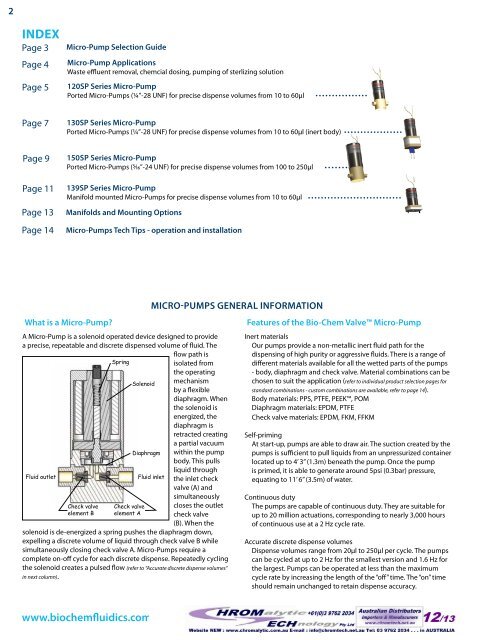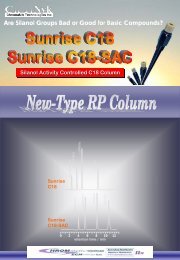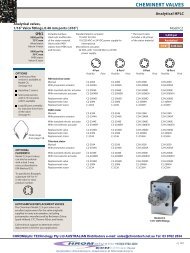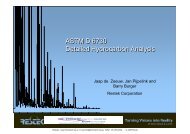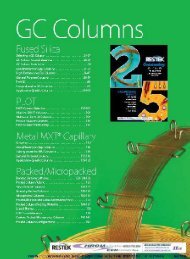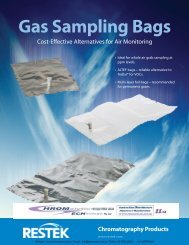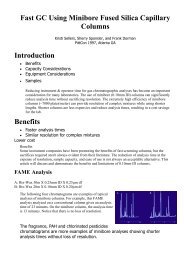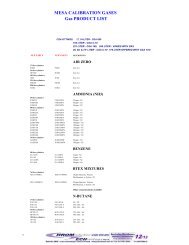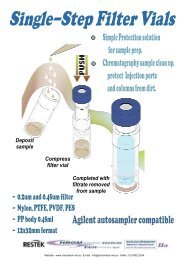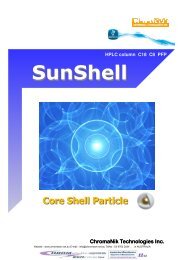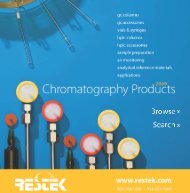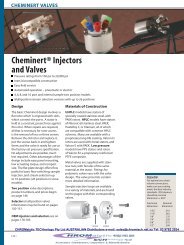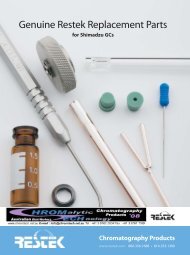Solenoid Operated Micro-Pumps
Solenoid Operated Micro-Pumps
Solenoid Operated Micro-Pumps
- No tags were found...
You also want an ePaper? Increase the reach of your titles
YUMPU automatically turns print PDFs into web optimized ePapers that Google loves.
2<br />
Index<br />
Page 3<br />
Page 4<br />
Page 5<br />
<strong>Micro</strong>-Pump Selection Guide<br />
<strong>Micro</strong>-Pump Applications<br />
Waste effluent removal, chemcial dosing, pumping of sterlizing solution<br />
120SP Series <strong>Micro</strong>-Pump<br />
Ported <strong>Micro</strong>-<strong>Pumps</strong> (1/4”-28 UNF) for precise dispense volumes from 10 to 60µl<br />
Page 7<br />
130SP Series <strong>Micro</strong>-Pump<br />
Ported <strong>Micro</strong>-<strong>Pumps</strong> (1/4”-28 UNF) for precise dispense volumes from 10 to 60µl (inert body)<br />
Page 9<br />
Page 11<br />
Page 13<br />
Page 14<br />
150SP Series <strong>Micro</strong>-Pump<br />
Ported <strong>Micro</strong>-<strong>Pumps</strong> (5/16”-24 UNF) for precise dispense volumes from 100 to 250µl<br />
139SP Series <strong>Micro</strong>-Pump<br />
Manifold mounted <strong>Micro</strong>-<strong>Pumps</strong> for precise dispense volumes from 10 to 60µl<br />
Manifolds and Mounting Options<br />
<strong>Micro</strong>-<strong>Pumps</strong> Tech Tips - operation and installation<br />
micro-pumps general inforMATion<br />
What is a <strong>Micro</strong>-Pump<br />
A <strong>Micro</strong>-Pump is a solenoid operated device designed to provide<br />
a precise, repeatable and discrete dispensed volume of fluid. The<br />
Fluid outlet<br />
Check valve<br />
element B<br />
Spring<br />
<strong>Solenoid</strong><br />
Check valve<br />
element A<br />
Diaphragm<br />
Fluid inlet<br />
flow path is<br />
isolated from<br />
the operating<br />
mechanism<br />
by a flexible<br />
diaphragm. When<br />
the solenoid is<br />
energized, the<br />
diaphragm is<br />
retracted creating<br />
a partial vacuum<br />
within the pump<br />
body. This pulls<br />
liquid through<br />
the inlet check<br />
valve (A) and<br />
simultaneously<br />
closes the outlet<br />
check valve<br />
(B). When the<br />
solenoid is de-energized a spring pushes the diaphragm down,<br />
expelling a discrete volume of liquid through check valve B while<br />
simultaneously closing check valve A. <strong>Micro</strong>-<strong>Pumps</strong> require a<br />
complete on-off cycle for each discrete dispense. Repeatedly cycling<br />
the solenoid creates a pulsed flow (refer to “Accurate discrete dispense volumes”<br />
in next column).<br />
Features of the Bio-Chem Valve <strong>Micro</strong>-Pump<br />
Inert materials<br />
Our pumps provide a non-metallic inert fluid path for the<br />
dispensing of high purity or aggressive fluids. There is a range of<br />
different materials available for all the wetted parts of the pumps<br />
- body, diaphragm and check valve. Material combinations can be<br />
chosen to suit the application (refer to individual product selection pages for<br />
standard combinations - custom combinations are available, refer to page 14).<br />
Body materials: PPS, PTFE, PEEK, POM<br />
Diaphragm materials: EPDM, PTFE<br />
Check valve materials: EPDM, FKM, FFKM<br />
Self-priming<br />
At start-up, pumps are able to draw air. The suction created by the<br />
pumps is sufficient to pull liquids from an unpressurized container<br />
located up to 4’ 3” (1.3m) beneath the pump. Once the pump<br />
is primed, it is able to generate around 5psi (0.3bar) pressure,<br />
equating to 11’ 6” (3.5m) of water.<br />
Continuous duty<br />
The pumps are capable of continuous duty. They are suitable for<br />
up to 20 million actuations, corresponding to nearly 3,000 hours<br />
of continuous use at a 2 Hz cycle rate.<br />
Accurate discrete dispense volumes<br />
Dispense volumes range from 20µl to 250µl per cycle. The pumps<br />
can be cycled at up to 2 Hz for the smallest version and 1.6 Hz for<br />
the largest. <strong>Pumps</strong> can be operated at less than the maximum<br />
cycle rate by increasing the length of the “off” time. The “on” time<br />
should remain unchanged to retain dispense accuracy.<br />
www.biochemfluidics.com


